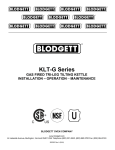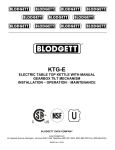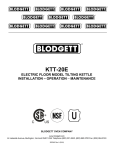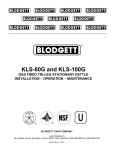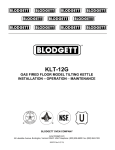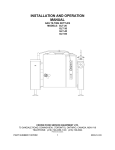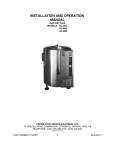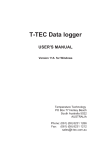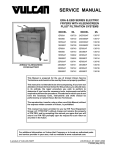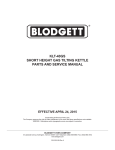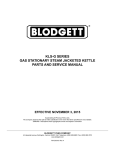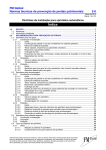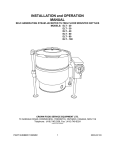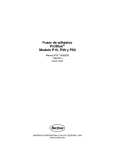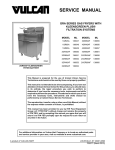Download Blodgett KLT-12G User's Manual
Transcript
KLT-12G GAS FIRED FLOOR MODEL TILTING KETTLE INSTALLATION – OPERATION – MAINTENANCE BLODGETT OVEN COMPANY IMPORTANT NOTES FOR INSTALLATION AND OPERATION www.blodgett.com 44 Lakeside Avenue, Burlington, Vermont 05401 USA Telephone (800) 331-5842, (802) 860-3700 Fax: (802) 864-0183 1 A (5/04) S00073 Rev It is recommended that this manual be read thoroughly and that all instructions be followed carefully. This is the safety alert symbol. It is used to alert you to potential personal injury hazards. Obey all safety messages that follow this symbol to avoid possible injury or death. 2 TABLE OF CONTENTS DESCRIPTION PAGE 1.0 IMPORTANT NOTES FOR INSTALLATION AND OPERATION........................... 2 2.0 SERVICE CONNECTIONS ................................................................................... 4 3.0 INTRODUCTION ................................................................................................... 5 4.0 INSTALLATION INSTRUCTIONS .......................................................................... 6 5.0 OPERATING INSTRUCTIONS ............................................................................. 9 6.0 PERIODIC MAINTENANCE ................................................................................ 11 7.0 TROUBLESHOOTING ........................................................................................ 14 APPENDIX A Material Safety Data Sheet....................................................................... 15 3 2.0 SERVICE CONNECTIONS MODEL SERVICE CONNECTIONS BTU/HR. kW/HR. 43,000 12.6 Unless otherwise specified, Field Wire Electrical Connection to be 120 Volts, 60 Hz. single phase with grounding wire. Unit furnished with 6' cord and 3 prong plug. Total max. amps 2.0. KLT-12G GAS CONNECTION: Supply gas through 3/4" pipe. NATURAL 6" - 14" W.C. (152mm - 355mm W.C.) PROPANE 12" - 14" W.C. (305mm - 355mm W.C.) Contact manufacturer for installation over 2,000 ft. elevation. 3 [76] 4.75 [121] 23.75 [603] 25.388 [645] DIMENSIONS ARE IN INCHES [MM] FLANGED FOOT DETAIL 4 EQUALLY SPACED Ø7/16" [11mm] HOLES ON 3 [76] B.C. Ø20 [508] 5.5 [140] 55.75 [1416] 23.88 [607] 32.88 [835] 15.88 [403] 6 [152] 12.50 [317] 6 [152] MIN. Ø16.75 [425] I.D. POUR PATH 30 [762] 11.25 [286] 15 [381] 4 17.25 [438] 7.75 [197] 3.0 INTRODUCTION DESCRIPTION Model KLT-12G (12 gallon capacity) gas fired, self-contained, tilting kettle. The kettle has a jacket of double-wall construction forming a sealed reservoir around the lower two-thirds of the kettle. The reservoir is charged with distilled water. The kettle is equipped with a “clean lock” to hold kettle in cooking position or tilted 105 degrees for ease of cleaning. The kettle is also equipped with automatic ignition, low water cut off and tilt switch, which, when activated, shuts down the burner. BASIC FUNCTION The kettle operates by generating steam in the kettle reservoir. The sequence of operation is as follows: 1. Operator turns the power switch to the on position and sets the temperature control dial to the desired setting. 2. The red light comes on indicating the kettle is heating. The green “IGNITION” light comes on indicating that the ignition and burner are active. 3. Once the kettle reaches the set temperature, the red “TEMPERATURE” light and the green “IGNITION” light extinguish. 4. All kettles are supplied with sufficient water in the jacket. If for any reason the water level falls below the required amount to operate the kettle, the burner shuts down and the amber light comes on. See Adding Water in Service section. 5. The sight glass indicates the water level within the kettle jacket. 6. The relief valve is a safety feature which prevents the internal kettle pressure from exceeding 50 PSI. It should never be tampered with. 5 4.0 INSTALLATION INSTRUCTIONS GENERAL Gas installation to conform to local codes or in absence of local codes to the National Fuel Gas Code - ANSI Z223.1 - latest edition. In Canada, installation to be according to CAN/CGA- B149.1 (NAT) or CAN/CGA-B149.2 (LP) installation codes as applicable. 1. The appliance and its individual shut-off valve must be disconnected from the gas supply piping system during any pressure testing of that system at pressures greater than ½ psig (3.45 Kpa). 2. The appliance must be isolated from the gas supply piping system by closing its individual manual shut off valve during any pressure testing of the gas supply piping system at test pressures equal to or less than ½ psig (3.45 Kpa). The installer must provide electrical grounding according to local codes, or in the absence of local codes, with the National Electrical Code, ANSI/NFPA 70 - latest edition. In Canada installation must be according to the C.S.A. C22.2 Canadian Electrical Code. WARNING ELECTRICAL GROUNDING INSTRUCTIONS THIS APPLIANCE IS EQUIPPED WITH A THREE-PRONG (GROUNDING) PLUG FOR YOUR PROTECTION AGAINST SHOCK HAZARD AND SHOULD BE PLUGGED DIRECTLY INTO A PROPERLY GROUNDED THREE-PRONG RECEPTACLE. DO NOT CUT OR REMOVE THE GROUNDING PRONG FROM THIS PLUG. (120 VOLT UNITS ONLY). The electrical wiring diagram is located inside the right hand console of the appliance. If applicable, the vent line from the gas appliance pressure regulator shall be installed to the outdoors in accordance with the local codes or, in the absence of local codes, with the National Fuel Gas Code, ANSI Z223.1, Natural Gas Installation Code, CAN/CGA-B149.1, or the Propane Installation Code as applicable. 6 GAS CONNECTION 1. The Serial and Rating Plate on the unit indicates the type of gas your unit is equipped to burn. DO NOT connect to any other gas type. 2. A 3/4" NPT line is provided at rear for the connection. The unit is equipped with an internal pressure regulator which is set at 4" W.C. manifold pressure for Natural Gas and 10" W.C. for Propane Gas. Use 1/8" pipe tap on the union elbow assembly located in the console for checking pressure. An adequate gas supply is imperative. Undersized or low pressure lines will restrict the volume of gas required for satisfactory performance. A steady supply pressure, minimum 6" W.C. for natural gas and minimum 12" W.C. for propane gas is recommended. With all units operating simultaneously, the manifold pressure on all units should not show any appreciable drop. Fluctuations of more than 25% on natural gas and 10% on propane gas will create problems, affecting burner operation. Contact you gas company for correct supply line sizes. Purge the supply line to clean out any dust, dirt or other foreign matter before connecting the line to the unit. Use pipe joint compound which is suitable for use with L.P. on all threaded connections. Test pipe connections thoroughly for gas leaks. USE SOAPY WATER ONLY FOR TESTING ON ALL GASES. NEVER USE AN OPEN FLAME TO CHECK FOR GAS LEAKS. ALL THE CONNECTIONS MUST BE CHECKED FOR LEAKS, AFTER THE UNIT HAS BEEN PUT IN OPERATION. 7 INSTALLATION 1. Uncrate carefully. Report any hidden freight damage to the freight company immediately. 2. Ideally an exhaust system should be directly above the appliance to exhaust combustion gases generated by the unit. 3. The appliance is intended for use on noncombustible floors. The minimum clearance from combustible and noncombustible floor construction is 0" on right side, 0" on left side and 6" (152 mm) from the back of the flue chimney. 4. Appliance location must allow air supply to unit and obstruction free clearance for air opening into the combustion chamber. 5. Set the appliance in place and level using spirit level. Level left to right and front to back. 6. Mark hole locations on the floor through the anchoring holes provided in the flanged adjustable feet. 7. Remove the appliance from installation position and drill holes in locations marked on the floor. (See installation diagram on Page 4). Insert proper anchoring devices. (Not supplied). 8. Place appliance back in the installation position and re-level left to right and front to back. 9. Bolt and anchor appliance securely to the floor. 10. Seal bolts and flanged feet with silastic or equivalent compound. 11. Make service connections as indicated. 12. The pressure relief valve is located at the left rear of the unit. This area should be kept clear and should not be in an area where operators will normally stand. The elbow on the relief valve should be turned toward the floor. 3/4" diameter pipe may be used to extend to the floor, but must not be piped directly to a drain. It must be vented to the atmosphere. 13. Check the pressure gauge on the front panel before operating. The reading should be in the green vacuum zone (below 0 PSI). See “Re-establishing Vacuum” section under Service Instructions. 8 5.0 OPERATING INSTRUCTIONS FRONT PANEL CONTROLS: Power Switch This switch turns the main power to the unit on and off. It must be turned on to heat the kettle. It should be turned off when the kettle will not be in use for long periods. Thermostat Selects the desired internal kettle operating temperature. It also turns on the temperature light (red) and ignition light (green). Temperature Pilot Light (Red) When the kettle has reached set temperature, temperature light (red) will go off. Ignition Pilot Light (Green) Comes on with temperature light (red) and indicates ignition has occurred. Should it not come on with temperature light, this would indicate failed ignition or burnt out light. Low Water Light (Amber) All kettles are supplied with sufficient water in the pressurized jacket. If at any time the water level falls below that required for proper operation, the kettle will not heat and this light will come on. See “Adding Water” section of service instructions. Pressure Gauge The pressure gauge indicates the internal operating pressure of the kettle. Sight Glass The sight glass indicates the water level within the kettle jacket. Pressure Relief Valve The pressure relief valve is a safety device which prevents the internal kettle pressure from exceeding 50 psi. It should never be tampered with. 9 TILTING INSTRUCTIONS Your kettle has the standard “Clean Lock” feature and may not be tilted without disengaging the tilt knob located on the console at the top left. This feature locks the kettle in the upright position and also allows the operator to lock the kettle at 105 degrees for ease of cleaning. Follow these steps to tilt kettle: 1. Pull out the tilt knob at the top left of console. 2. Using kettle tilt handle, pull kettle forward to desired angle of pour or until kettle locks at 105 degrees. The tilt knob can be released after the kettle has been tilted approximately 10 degrees. 3. Kettle will lock in position at 105 degrees and may be tilted further by pulling the tilt lock knob a second time allowing the kettle to tilt the full distance. 4. To return the kettle to the upright position, pull out the tilt lock knob and tilt the kettle upward until it locks in the upright position. The kettle should not move in either direction once in the upright position. LIGHTING 1. Ensure the kettle is in the upright position. 2. Open the manual gas shut off valve located at the back of the right-hand console when facing the front of the unit. 3. Set the thermostat dial in off position. Turn the power switch on. 4. Set the thermostat to desired setting. If ignition light does not stay on, turn off thermostat. Wait 5 minutes and repeat the lighting procedure. NOTICE IF THE GAS SUPPLY IS INTERRUPTED DURING OPERATION, A FIVE MINUTE PERIOD OF COMPLETE SHUT OFF OF GAS SUPPLY IS REQUIRED BEFORE SHUT DOWN 1. Turn thermostat dial to “OFF” position. 2. Turn power switch to “OFF” position. 3. Close manual gas shut-off valve. 10 6.0 PERIODIC MAINTENANCE NOTICE AS A SAFETY PRECAUTION, DISCONNECT THE POWER SUPPLY DURING CLEANING OR SERVICING. WARNING AT LEAST TWICE A YEAR, HAVE AN AUTHORIZED SERVICE PERSON CLEAN AND ADJUST THE UNIT FOR MAXIMUM All units are adjusted at the factory. In order to avoid problems in operation, check type of gas and manifold pressure at initial installation and compare it with information on the rating plate. CLEANING The gas fired tilting kettle should be cleaned after each use. CONTACT THE FACTORY, THE FACTORY REPRESENTATIVE OR A LOCAL SERVICE COMPANY TO PERFORM MAINTENANCE AND 1. Always keep exposed cleanable areas of the unit clean. 2. Thoroughly wash kettle and lid. Use mild detergent and clear water. 3. Stuck-on food should be soaked in warm water and mild detergent. Never use scouring pads or abrasive cleaners as this will result in scratches on the surface finish. 4. Rinse the entire unit and dry. Do not get water in electrical boxes, combustion chamber or any electrical component. 5. Visually assure that the louvers on the covers are unobstructed. 11 WARNING IT IS NOT RECOMMENDED TO USE CLEANING AGENTS THAT ARE CORROSIVE. CLEANING AGENTS THAT CONTAIN CHLORIDES, ACIDS OR SALTS ARE CORROSIVE AND MAY CAUSE PITTING AND CORROSION WHEN USED OVER A PERIOD OF TIME; THIS WILL REDUCE THE LIFE OF THE APPLIANCE. SHOULD PITTING OR CORROSION OCCUR THIS IS NOT COVERED BY WARRANTY. FOLLOW THE RECOMMENDED CLEANING INSTRUCTIONS. USE A MILD DETERGENT, WARM WATER AND RINSE THOROUGHLY. GENERAL SERVICE In order to avoid problems, check that the unit has been connected to the gas supply type and voltage for which it was supplied. This can be done by examining the rating plate that lists the gas type and voltage for which the unit was manufactured. PRESSURE SWITCH The pressure switch is preset for proper operation from the factory and should not be adjusted until it is determined to be the cause of an operating pressure deficiency. Appliance malfunctions caused by pressure switch misadjustment are: 1. Pressure relief valve opening, especially on preheat from a cold start to 285 EF (pressure switch set too high.) 2. Burners being shut down prematurely by the pressure switch (pressure switch set is too low). If adjustment of the pressure switch is required, it should be done as follows: 1. With the kettle empty and completely cold, turn kettle on and set thermostat between 7 - 8. 2. Pressure in kettle (read pressure gauge on front panel) should reach a maximum pressure of 40 psi and pressure relief valve should not open. Kettle pressure may rise 3 or 4 psi even after burners shut down. 3. If relief valve did not open when kettle pressure reached 40 psi, the pressure switch setting is satisfactory. 4. To obtain access to the pressure switch, remove the front panel. 5. To increase the pressure switch setting, turn white ribbed knob clockwise; to decrease turn 12 counterclockwise. Use the centre of the black ring as an indicator. 6. If relief valve opens, reduce setting on pressure switch, cool kettle completely by filling with cold water and repeat this procedure. 7. If pressure in kettle is below 40 psi, increase setting on pressure switch, cool kettle completely by filling with cold water and repeat this procedure. 8. Replace the front panel when adjustment is complete. ADDING WATER When the “Low Water” light is on, additional water is required and the following steps must be followed: 1. Unit should be completely cold and off. 2. Lift handle of pressure relief valve to release the remaining vacuum in the kettle. 3. Remove air vent nut of the elbow located at the rear right of the unit. 4. Pour 72 ounces of distilled water into the open end of the elbow (a funnel will be helpful). 5. Replace and tighten nut. Be sure to seal threads with pipe joint compound suitable for steam at 50 psi. 6. Vacuum must now be re-established. See following section. RE-ESTABLISHING VACUUM Periodically check pressure gauge when kettle is cold. It should be in green vacuum zone (below 0 psi). Otherwise air is present and proper heating will not occur. To remove air: 1. Set temperature dial to 7 and heat empty kettle until pressure gauge indicates 5-10 psi. 2. Open air vent nut one half turn to release air for 10 to 15 seconds; then close and re-tighten. 3. Proper vacuum in the kettle should now be re-established. 13 7.0 TROUBLESHOOTING Unit does not come on: 1. Power switch and/or thermostat is “OFF”. 2. Unit is not plugged in. 3. Main power supply is off. 4. Tilt micro switch out of alignment or faulty. Unit is on electrically but does not heat: 1. Gas supply to the unit is “OFF”. 2. The manual shut-off valve is “OFF”. 3. The thermostat is not turned “ON.” 4. The kettle is not in the upright position. 5. The electronic ignition is not functioning. 6. Pressure switch is not functioning. 7. Low water in kettle jacket. 8. Thermostat is not functioning. Unit is slow to preheat and slow to recover: 1. Wrong size orifices. 2. Wrong gas supply. 3. Incorrect pressure at supply. 4. Loss of vacuum. 14 APPENDIX ‘A’ MATERIAL SAFETY DATA SHEET PREPARATION INFORMATION: Prepared for use in Canada by: E H & S Product Regulatory Management Department DOW CHEMICAL CANADA INC. P.O. Box 1012 Sarnia, Ontario, N7T 7K7 (800) 331-6451 1. CHEMICAL PRODUCT AND COMPANY IDENTIFICATION IN CASE OF EMERGENCY: Fort Saskatchewan, Alberta: (780) 998-8282 Sarnia, Ontario: (519) 339-3711 Varennes, Quebec: (450) 652-1000 Product:: DOWFROST* HD HEAT TRANSFER FLUID, DYED Product Code: 04632 Effective Date: 2/20/01 Date Printed: 07/10/02 MSD: 002239 DOW CHEMICAL CANADA INC. P.O. Box 1012 Sarnia, Ontario, N7T 7K7 Prepared for use in Canada by the E H & S Product Regulatory Management Department; Phone: (800) 331-6451. S COMPOSITION/INFORMATION ON INGREDIENTS Propylene Glycol CAS# 000057-55-6 Dipotassium PhosphateCAS# 007758-11-4 Deionized Water CAS# 007732-18-5 94% <5% * or (R) indicates a trademark of The Dow Chemical Company. 15 <5% S HAZARDS IDENTIFICATION EMERGENCY OVERVIEW Clear yellow liquid. Odourless. Avoid temperatures above 450EF, 232EC. POTENTIAL HEALTH EFFECTS (See Section 11 for toxicological data.) EYE: May cause slight transient (temporary) eye irritation. Corneal injury is unlikely. Mists may cause eye irritation. SKIN CONTACT: Prolonged contact is essentially nonirritating to skin. A single prolonged exposure is not likely to result in the material being absorbed through skin in harmful amounts. Repeated exposures may cause flaking and softening of skin. INGESTION: Single dose oral toxicity is considered to be extremely low. No hazards anticipated from swallowing small amounts incidental to normal handling operations. INHALATION: At room temperature, vapours are minimal due to physical properties. Mists may cause irritation of upper respiratory tract (nose and throat). SYSTEMIC (OTHER TARGET ORGAN) EFFECTS: Repeated excessive exposure to propylene glycol may cause central nervous system effects. CANCER INFORMATION: Did not cause cancer in laboratory animals. TERATOLOGY (BIRTH DEFECTS): Birth defects are unlikely. Exposures having no adverse effects on the mother should have no effect on the fetus. REPRODUCTIVE EFFECTS: In animal studies, has been shown not to interfere with reproduction. * or (R) indicates a trademark of The Dow Chemical Company. 16 4. FIRST AID EYES: Flush eyes with plenty of water. SKIN: Wash off in flowing water or shower. INGESTION: No adverse effects anticipated by this route of exposure incidental to proper industrial handling. INHALATION: Remove to fresh air if effects occur. Consult a physician. NOTE TO PHYSICIAN: No specific antidote. Supportive care. Treatment based on judgment of the physician in response to reactions of the patient. 5. FIRE FIGHTING MEASURES FLAMMABLE PROPERTIES FLASH POINT: 214EF, 107EC (based on a similar material) METHOD USED: PMCC AUTOIGNITION TEMPERATURE: NOT DETERMINED FLAMMABILITY LIMITS LFL: Not determined UFL: Not determined HAZARDOUS COMBUSTION PRODUCTS: During a fire, smoke may contain the original material in addition to unidentified toxic and/or irritating compounds. Hazardous combustion products may include and are not limited to carbon monoxide and carbon dioxide. * or (R) indicates a trademark of The Dow Chemical Company. OTHER FLAMMABILITY INFORMATION: Violent steam generation or eruption may occur upon application of direct water stream to hot liquids. Flammable concentrations of vapour can accumulate at temperatures above 214EF. Liquid mist of this product can burn. Spills of these organic liquids on hot fibrous insulations may lead to lowering of the autoignition temperatures 17 possibly resulting in spontaneous combustion. Container may rupture from gas generation in a fire situation. EXTINGUISHING MEDIA: Water fog or fine spray, carbon dioxide, dry chemical, foam. Alcohol resistant foams (ATC type) are preferred if available. General purpose synthetic foams (including AFFF) or protein foams may function, but much less effectively. Do not use direct water stream. May spread fire. MEDIA TO BE AVOIDED: Do not use direct water stream. FIRE FIGHTING INSTRUCTIONS: Keep people away. Isolate fire area and deny unnecessary entry. Burning liquids may be moved by flushing with water to protect personnel and minimize property damage. Burning liquids may be extinguished by dilution with water. Do not use direct water stream. May spread fire. Fight fire from protected location or safe distance. Consider use of unmanned hose holder or monitor nozzles. Use water spray to cool fire exposed containers and fire affected zone until fire is out and danger of re-ignition has passed. Immediately withdraw all personnel from area in case of rising sound from venting safety device or discolouration of the container. Move container from fire area if this is possible without hazard. PROTECTIVE EQUIPMENT FOR FIRE FIGHTERS: Wear positive-pressure self-contained breathing apparatus (SCBA) and protective fire fighting clothing (includes fire fighting helmet, coat, pants, boots and gloves). If protective equipment is not available or not used, fight fire from a protected location or safe distance. 6. ACCIDENTAL RELEASE MEASURES (See Section 15 for Regulatory Information) PROTECT PEOPLE: Use appropriate safety equipment. For additional information, refer to Section 8, Exposure Controls/ Personal Protection. PROTECT THE ENVIRONMENT: Avoid contamination of all waterways. CLEAN-UP: See Section 13, Disposal Consideration. * or (R) indicates a trademark of The Dow Chemical Company. S HANDLING AND STORAGE SPECIAL PRECAUTIONS TO BE TAKEN IN HANDLING AND STORAGE: No special handling requirements data available. HANDLING: See Section 8, Exposure Controls/Personal Protection. STORAGE: See Section 10, Stability and Reactivity. 18 S EXPOSURE CONTROLS/PERSONAL PROTECTION ENGINEERING CONTROLS: Provide general and/or local exhaust ventilation to control airborne levels below the exposure guidelines. PERSONAL PROTECTIVE EQUIPMENT EYE/FACE PROTECTION: Use safety glasses. Safety glasses should be sufficient for most operations; however, for misty operations wear chemical goggles. SKIN PROTECTION: Use gloves impervious to this material. RESPIRATORY PROTECTION: Atmospheric levels should be maintained below the exposure guideline. When respiratory protection is required for certain operations, use an approved airpurifying respirator. In misty atmospheres, use an approved mist respirator. EXPOSURE GUIDELINES: Propylene glycol: AIHA WEEL is 50 ppm total, 10 mg/m3 aerosol only. 9. PHYSICAL AND CHEMICAL PROPERTIES APPEARANCE/PHYSICAL STATE: ODOUR: VAPOR PRESSURE: VAPOR DENSITY: BOILING POINT: SOLUBILITY IN WATER/MISCIBILITY: SPECIFIC GRAVITY OR DENSITY: Clear yellow liquid. Odourless 0.22 mmHg @ 20EC 2.6 320EF, 160EC Complete 1.058 @ 25/25EC * or (R) indicates a trademark of The Dow Chemical Company. 10. STABILITY AND REACTIVITY CHEMICAL STABILITY: Thermally stable at typical use temperatures. CONDITIONS TO AVOID: Avoid use temperatures above 450EF, 232EC. Product can degrade at elevated temperatures. Generation of gas during decomposition can cause pressure in closed systems. INCOMPATIBILITY WITH OTHER MATERIALS: Avoid contact with oxidizing materials. Avoid contact with strong acids 19 HAZARDOUS DECOMPOSITION PRODUCTS: Hazardous decomposition products depend upon temperature, air supply and the presence of other materials. HAZARDOUS POLYMERIZATION: Will not occur. 11. TOXICOLOGICAL INFORMATION (See Section 3 for Potential Health Effects. For detailed toxicological data, write or call the address or non-emergency number shown in Section 1). SKIN: The LD50 for skin absorption in rabbits is >10,000 mg/kg. SKIN: The LD50 for skin absorption in rabbits is >10,000 mg/kg. INGESTION: The oral LD50 for rats is 20,000 - 34,000 mg/kg. MUTAGENICITY: In vitro mutagenicity studies were negative. Animal mutagenicity studies were negative. S ECOLOGICAL INFORMATION (For detailed Ecological data, write or call the address or non-emergency number shown in Section 1.) ENVIRONMENTAL FATE MOVEMENT & PARTITIONING: Based largely or completely on data for major component(s). Bioconcentration potential is low (BCF less than 100 or Log Pow less than 3). Potential for mobility in soil is very high (Koc between 0 and 50). * or (R) indicates a trademark of The Dow Chemical Company. DEGRADATION AND PERSISTENCE: Based largely or completely on data for major component(s). Material is readily biodegradable. Passes OECD test(s) for ready biodegradability. Degradation is expected in the atmospheric environment within minutes to hours. ECOTOXICITY: Based largely or completely on data for major component(s). Material is practically non-toxic to aquatic organisms on an acute basis (LC50/EC50 >100 mg/L in most sensitive species). S DISPOSAL CONSIDERATIONS (See Section 15 for Regulatory Information) DISPOSAL: DO NOT DUMP INTO ANY SEWERS, ON THE GROUND OR INTO ANY BODY OF WATER. All disposal methods must be in compliance with all Federal, State/Provincial and 20 local laws and regulations. Regulations may vary in different locations. Waste characterizations and compliance with applicable laws are the responsibility solely of the waste generator. THE DOW CHEMICAL COMPANY HAS NO CONTROL OVER THE MANAGEMENT PRACTICES OR MANUFACTURING PROCESSES OF PARTIES HANDLING OR USING THIS MATERIAL. THE INFORMATION PRESENTED HERE PERTAINS ONLY TO THE PRODUCT AS SHIPPED IN ITS INTENDED CONDITION AS DESCRIBED IN MSDS SECTION 2 (Composition/Information On Ingredients). FOR UNUSED & UNCONTAMINATED PRODUCT, the preferred options include sending to a licensed, permitted: recycler, reclaimer, incinerator or other thermal destruction device. As a service to its customers, Dow can provide names of information resources to help identify waste management companies and other facilities which recycle, reprocess or manage chemicals or plastics, and that manage used drums. Telephone Dow’s Customer Information Center at 800-258-2436 or 989-832-1556 for further details. 14. TRANSPORT INFORMATION DEPARTMENT OF TRANSPORTATION (D.O.T.): For D.O.T. regulatory information, if required, consult transportation regulations, product shipping papers, or contact your Dow representative. CANADIAN TDG INFORMATION: For TDG regulatory information, if required, consult transportation regulations, product shipping papers, or your Dow representative. * or (R) indicates a trademark of The Dow Chemical Company. 15. REGULATORY INFORMATION (Not meant to be all-inclusive – selected regulations represented). NOTICE: The information herein is presented in good faith and believed to be accurate as of the effective date shown above. However, no warranty, express or implied is given. Regulatory requirements are subject to change and may differ from one location to another; it is the buyer’s responsibility to ensure that its activities comply with federal, state or provincial, and local laws. The following specific information is made for the purpose of complying with numerous federal, state or provincial, and local laws and regulations. See other sections for health and safety information. * or (R) indicates a trademark of The Dow Chemical Company. 21 U.S. REGULATIONS SARA 313 INFORMATION: To the best of our knowledge, this product contains no chemical subject to SARA Title III Section 313 supplier notification requirements. SARA HAZARD CATEGORY: This product has been reviewed according to the EPA “Hazard Categories” promulgated under Sections 311 and 312 of the Superfund Amendment and Reauthorization Act of 1986 (SARA Title III) and is considered, under applicable definitions, to meet the following categories: Not to have met any hazard category. TOXIC SUBSTANCES CONTROL ACT (TSCA): All ingredients are on the TSCA inventory or are not required to be listed on the TSCA inventory. STATE RIGHT-TO-KNOW: The following product components are cited on certain state lists as mentioned. Non-listed components may be shown in the composition section of the MSDS. CHEMICAL NAME CAS NUMBER LIST 1, 2-Propanediol 000057-55-6 PA1 PA1= Pennsylvania Hazardous Substance (present at greater than or equal to 1.0%). OSHA HAZARD COMMUNICATION STANDARD: This product is not a “Hazardous Chemical” as defined by the OSHA Hazard Communication Standard, 29 CFR 1910.1200. * or (R) indicates a trademark of The Dow Chemical Company. 22 CANADIAN REGULATIONS WHMIS INFORMATION: The Canadian Workplace Hazardous Materials Information System (WHMIS) Classification for this product is: This product is not a “Controlled Product” under WHMIS. CANADIAN ENVIRONMENTAL PROTECTION ACT (CEPA) This product contains one or more substances which are not listed on the Canadian Domestic Substances List (DSL). Contact your Dow representative for more information. 16. OTHER INFORMATION MSDS STATUS: Revised to 16 section format. The information herein is given in good faith, but no warranty, express or implied, is made. Consult The Dow Chemical Company for further information. * or (R) indicates a trademark of The Dow Chemical Company. 23
























